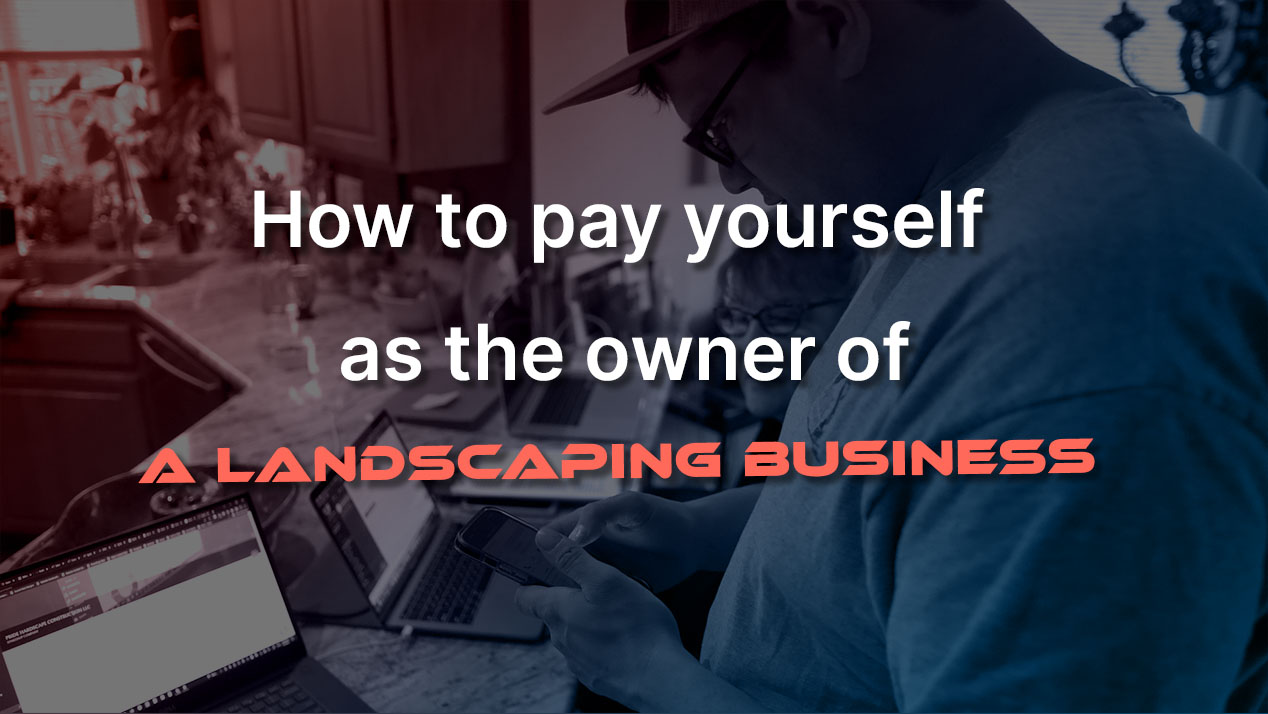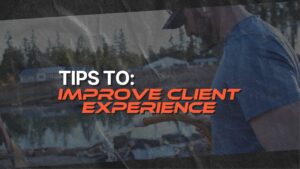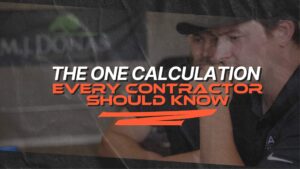How to Pay Yourself as the Owner of a Landscape Business

How to pay yourself
I often run into this topic as I’m working with owners of landscape businesses all over North America at SynkedUP: How to pay yourself as the owner of a landscape business?
Well, let’s start with the basic concept:
You as the owner, and the business you own, are two separate entities.
The owner needs to be paid for the work they do + the business needs to earn a profit.
This means the business’s profit doesn’t count as your owner’s pay. (Assuming you’re not an absentee owner)
The business needs to pay the owner salary for the market value of the duties they do in the business, AND the business needs to make a profit. AFTER paying that owner’s salary.
So let’s draw up examples of how to pay yourself:
Bad example:
$1m revenue business with a 10% net profit of $100k. The owner did not take a salary. Instead, they take the $100k business net profit as their pay. Meaning after paying the owner, the business made 0% profit. No money.
Good example:
$1m revenue business with a 10% net profit of $100k AFTER paying the owner a $100k salary. This means the owner’s salary and business net profit together is $200k.
The owner got paid market value salary for their day-to-day duties in the business,
The business still earned a profit.
In the bad example, the business is left with no money to grow the business.
Need to invest in hiring an office admin to take things off of the owner’s plate? No money to do it.
Need to upgrade your vehicle? No money to do it.
Need to invest in some marketing? No money to do it.
Do you get the idea?
In a good example, the owner is already paid, and their living expenses and personal finances are being covered.
Plus there’s money left to invest in future growth and strategic investments for the business.
It takes money to make money.
Need to invest in hiring an office admin to take things off of the owner’s plate? Sure, let’s take business profit and invest in an office admin. Might put a hit on the business profits that year, but the investment will lead to buying back the owner’s time, allowing the owner to work on the business, not in the business. Which has the effect of making the business better, better processes and systems, happier team members, and better profits in the long run. Not to mention better work/lifestyle for the owner.
Need to upgrade your vehicle? Use cash instead of paying interest.
Need to invest in some marketing? You can invest and generate a larger ROI in the future.
In the bad example, the business owns you as the owner. The business is getting you for free.
In the good example, you as the owner own the business. Leading strategically, being proactive, not reactive.
How much should you as the owner pay yourself?
Owners should pay themselves the market value of what they do, and the responsibilities they cover, in the business.
Meaning, if you are doing the work of 3 people, the business needs to pay you the salaries of 3 people. Otherwise, the business is getting you at a discount. And if you ever decide you want to do the work of 2 people instead of 3, the money won’t be there to make it happen.
I know owners of landscape businesses that are doing the work of 3 people. If they suddenly decided to become an absentee owner, they’d have to hire an office admin, an ops manager, and a salesperson.
Maybe the owner is like, eh, I can live on $50k a year.
But an office admin would cost $40k
Ops manager – $80k
Salesperson – $100k with base + commission
Add all of those up that’s $220k.
So, even though the owner could live on $50k a year, the business should not pay the owner that. It should be budgeted to pay the owner the $220k.
Whether the owner actually takes all of that $220k home or leaves some of that back in the business is up to them. I don’t care. Either way, it’s the owner’s money that they control. However, the business needs to be budgeting for that $220k so that the business’s pricing is based on realistic numbers that are aligned with market value.
Now, for an absentee owner who doesn’t have any day-to-day responsibilities, their reward or compensation is the net profit of the business. Absentee owners should not technically be taking any salary. The people making the business’s daily functions work are those who should be getting paid a salary.
Absentee owners can decide what they want to do with the business’s net profits. Take it all out or reinvest it back into the business. Or some of both.
But that actually is the correct example of how an owner could only be taking net profits and no salary.
A working owner needs a salary + gets to make the same decisions as the absentee owner on what happens to the business’s net profits, leave it in and reinvest, or take it out.
So what to do?
To keep it clean, you need two separate bank accounts: a personal and a business checking account.
If you live out of the business checking, that’s the first thing to get squared away.
Separate it!
So you can see where the money is. It’s impossible to keep it clean when both the business and the owner are living from the same account.
Next, build a company budget to ensure you are pricing your work correctly. What a budget will allow you to do is input all the costs the business needs to pay for labor, materials, equipment, overhead expenses, and the market value salary of the owner.
The output you will get from your budget is exactly what your labor rate or man-hour rate needs to be, and overhead recovery markups need to be to actually realize your profit goals.
Meaning the business actually realizes the net profit it should be making after paying all those expenses. (and not breaking even, where all bills are paid, yes, but the business made no money)
SynkedUP is a software tool that automates all this math. It allows you to input all your costs, and get all your “answers” back out as to what your rates need to be, so you can go bid that next job correctly to properly cover all those expenses + earn a profit. SynkedUP has drag-and-drop estimating, templates, and production rates that make estimating fast and automated. No brain power is being sucked up by the math and rates. Check it out here
That said, regardless of whether you use paper and pen, spreadsheets, or a software product, the math needs to be done and the costs need to be considered and properly accounted for.
I made a free budgeting tool available to anyone, even if you don’t use SynkedUP.
AND… if you’d like to dig in and then want to have an expert look over your shoulder at your budget, schedule a free budget call with our team! We’ll sanity-check it with you.
If you do use SynkedUP, and want to dig into this and review your budget inside the software, book a call with our experts! (only for active SynkedUP users)
I hope this was helpful! Hit me up in the replies or comments for any specific questions you have or any comments you’d like to add.
Cheers!
Weston Zimmerman

Weston Zimmerman
CEO and co-founder
See SynkedUP in action
Related Articles
Tips To: Improve Client Experience
Cutting costs isn't the same as saving money. Learn how to use leverage, not panic, to drive real profit and...
What is the Most Difficult Challenge You’ve Overcome?
Cutting costs isn't the same as saving money. Learn how to use leverage, not panic, to drive real profit and...
Why Time Tracking is Critical for Contractors
Cutting costs isn't the same as saving money. Learn how to use leverage, not panic, to drive real profit and...
Why Cutting Costs Isn’t the Same as Saving Money
Cutting costs isn't the same as saving money. Learn how to use leverage, not panic, to drive real profit and...
Slow Down to Speed Up
A quick leadership gut check: Are you building what really matters? Slow down, realign, and lead with intention.
The One Calculation Every Contractor Should Know
Contractors: If you’re not factoring in overhead, you're not pricing right. Learn how to calculate breakeven and stop guessing your...
What Owns Your Day? Urgency or Importance?
Stuck in a cycle of chaos and urgent tasks? Break the cycle with better systems, clear processes, and leadership that...
Taking Care of Your Team
Leadership isn't barking orders - it's listening, appreciating, and building problem solvers. Here's how to lead without burning out.
The Cost of Avoiding Issues in Your Business
Avoiding stuff in business adds up, with interest. Don't try harder, build systems that make success default. Do hard things,...
Leveraging Your Job Data for More Accurate Estimates
Stop estimating from the gut. Track time, collect job data, and turn it into faster, more accurate production rates.









